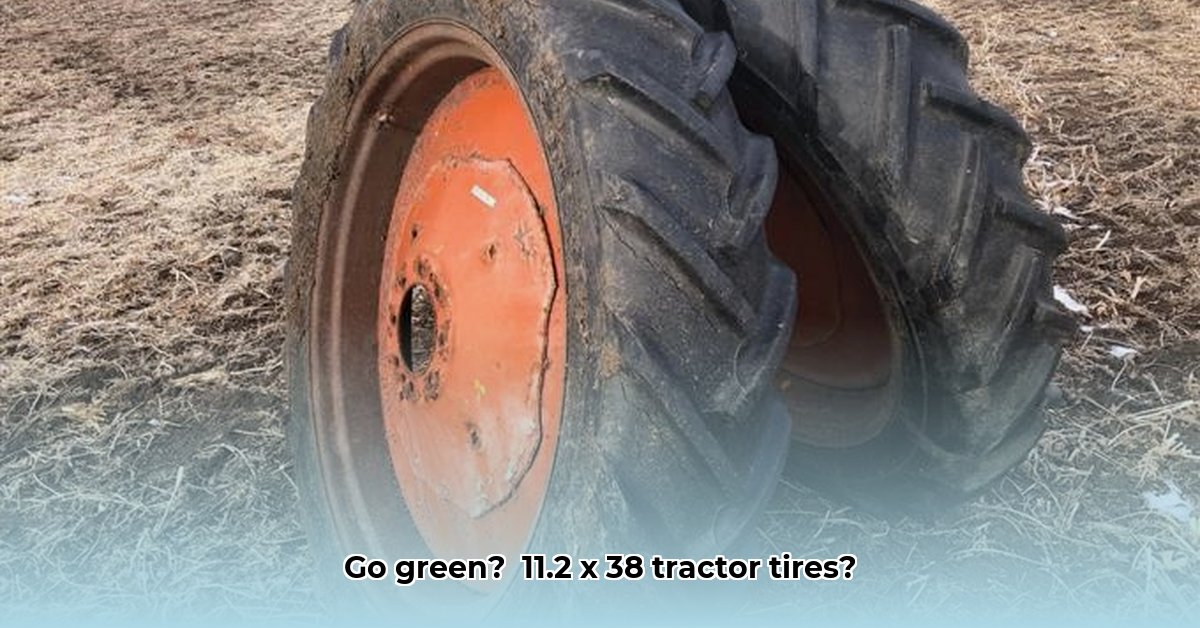
11.2 x 38 Tractor Tires: Balancing Cost and Sustainability
Efficient farming hinges on reliable equipment, and tractor tires are paramount. The 11.2 x 38 size is a common choice, but the environmental impact of these essential components is increasingly under scrutiny. This article examines current market options, highlighting durability, traction, and environmental factors. We'll explore the trade-offs between cost-effective choices (like the Firestone Field and Road tire) and the growing demand for sustainable alternatives. The goal is to provide actionable insights for farmers and stakeholders seeking to minimize their environmental footprint while maintaining operational efficiency. For more sizes, check out other tractor tire sizes.
The Current Market Landscape: A Cost-Effectiveness Conundrum
The current market for 11.2 x 38 tractor tires often prioritizes affordability. Tires like the Firestone Field and Road 1 are popular due to their robust performance and competitive price. However, this cost-effectiveness often comes at an environmental cost. Traditional manufacturing processes—from resource extraction to energy consumption—contribute significantly to greenhouse gas emissions and resource depletion. Furthermore, the end-of-life disposal of these tires often involves landfilling, adding to waste accumulation. This raises a key question: How can farmers balance the need for reliable, durable tires with the growing imperative for environmentally sound practices?
Environmental Impacts of Tractor Tire Manufacturing: A Detailed Look
Producing agricultural tires has a significant environmental footprint. The production of rubber, a key component, traditionally relies on petroleum, a finite and environmentally damaging resource. Manufacturing is energy-intensive, leading to increased carbon emissions. The use of various chemicals and the generation of manufacturing byproducts further compound the environmental impact. Tire disposal adds to the problem, as many end up in landfills, where they persist for decades. This necessitates a shift towards sustainable manufacturing practices and responsible end-of-life management.
Sustainable Innovations: Paving the Way for Greener Tires
Fortunately, the agricultural tire industry is embracing innovation to create more sustainable solutions. Several promising avenues are emerging:
Bio-based rubber: Utilizing guayule or other plants as a renewable source of rubber offers a potential solution to reduce reliance on petroleum.
Recycled materials: Incorporating recycled materials into new tire construction minimizes landfill waste and reduces the demand for virgin resources.
Improved tire designs: Innovations focusing on enhanced fuel efficiency and extended tire lifespan decrease the overall environmental impact over the tire's life cycle.
Sustainable disposal and recycling: Developing and implementing effective tire recycling programs creates a closed-loop system for resource recovery.
Comparative Analysis: The Need for Standardized Data
A comprehensive comparison of different 11.2 x 38 tire options, considering lifecycle costs and environmental performance, is critical. This would entail evaluating factors such as:
- Initial Cost: Upfront purchase price.
- Operational Costs: Fuel efficiency, maintenance, and overall performance.
- Environmental Impact: Carbon footprint, resource consumption, and disposal methods.
- Lifespan: Tire durability before replacement.
Currently, standardized data across various brands and models is lacking. However, as research progresses and more sustainable tires enter the market, such comparative analyses will become increasingly valuable.
Actionable Recommendations: A Collaborative Approach
Achieving a sustainable future for agricultural tires requires collaboration among various stakeholders:
Tire Manufacturers: Invest in R&D of bio-based materials and improved designs. Increase transparency regarding environmental impact data. Develop robust recycling programs.
Farmers: Prioritize tires with high durability and traction. Consider the long-term cost-benefit analysis, including fuel efficiency and lifespan. Employ practices to minimize soil compaction.
Policy Makers: Implement incentives (tax breaks, subsidies) to encourage the adoption of sustainable tires. Enact stricter regulations on end-of-life tire management.
Researchers: Conduct independent analyses, develop detailed lifecycle assessment methodologies, and promote standardized test protocols.
Conclusion: Towards a More Sustainable Agricultural Future
The transition to sustainable agricultural tires is not just an environmental imperative; it is also a pathway to improved economic viability for farmers. By embracing innovation, collaboration, and transparent data, we can create a more responsible and prosperous future for the agricultural sector. The journey towards sustainable farming practices requires commitment from all stakeholders.